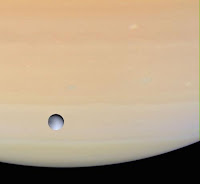
Over seven years ago (in October 1997) the Cassini/Huygens mission was launched. Cassini is the main satellite; Huygens hitched a ride on it. Between the launch and December 2004, the satellite used several planets as "slingshots" to boost its speed, until finally it arrived in the vicinity of its target: Saturn (and its largest moon, Titan). Just before Christmas, Cassini -- after seven years in the harsh conditions of interplanetary space -- fired its engines in a picture-perfect maneuver to put itself into orbit around the ringed planet.
Since its arrival in the Saturn "system", Cassini and Huygen have been making non-stop observations. They've generated huge quantities of data with far better sensitivity and resolution than anything ever collected before about Saturn. The photo at right is a great example: the moon Dione (which nobody had ever seen as more than a smudge before) with Saturn as a backdrop. BTW, you can click on the picture to see the Cassini/Huygen home page.
In January, Cassini flew near Titan and released Huygens on a trajectory that would end up with Huygens landing on the surface of that mooon. Huygen's journey was a scientific and technological marvel. It spent seven years turned off, as it depended on battery power and those batteries would only last a few hours. After it was released by Cassini, a simple timer inside Huygens told it when to switch on -- just a few moments before it plunged into Titan's thick methane-soup atmosphere. Then in a very precisely choreographed series of actions, Huygens used a heat shield, multiple parachutes, and in-air (so to speak) maneuvers until finally it was swinging below it's main parachute, slowly descending towards Titan's surface. And nobody knew what that surface would be composed of, so Huygens was prepared for anything from solid rock to liquid hydrocarbon. As it turned out, Huygens landed on something with the consistency of mud, and was able to take hundreds of photographs and instrument readings on the surrounding very interesting territory. Talk about Mr. Toad's wild ride!
There are dozens of triumphs already in the Cassini/Huygens mission, and many more to come. To date it has operated nearly flawlessly, and it is in perfect condition. I visit the mission web site almost every day to catch up on the latest amazing discoveries. Even though I'm used to the apparent general disinterest in science and technology (and I know I'm over-generalizing here), I've been very surprised how little interest most people seem to have with this mission. And I'm at a loss to explain why -- it seems to have all the elements of drama and action that would attract interest. What am I missing?

No comments:
Post a Comment